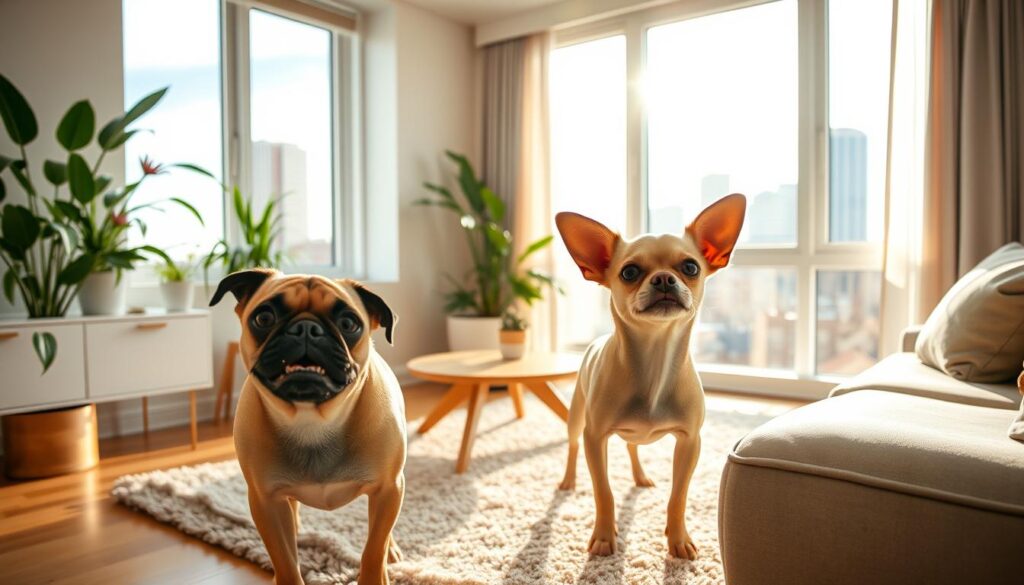Living in an apartment with a vocal dog can be tough. Excessive barking might upset neighbors and cause problems with building management. But, there are ways to keep peace in your home.
BarkingBatty.com helps dog owners deal with barking. They offer building management-approved solutions. These can help your dog bark less and live better.
Key Takeaways
- Understand the causes of excessive barking in dogs
- Implement effective training techniques to reduce barking
- Explore barking solutions that meet building management standards
- Maintain a positive relationship with neighbors and building administrators
- Discover resources and tools for managing vocal dogs in apartments
The Challenge of Vocal Dogs in Apartment Settings
Living in an apartment with a vocal dog can be tough. The close quarters and shared walls make barking worse. This can upset neighbors and strain relationships.
Dogs bark for many reasons, like protecting their territory or seeking attention. In apartments, things like hallway noise or elevator sounds can trigger barking. Knowing what causes barking is key to solving the problem.
Common Triggers for Barking in Apartment Environments
Apartment dogs often bark at noises from next door or people passing by. They might even bark at the elevator. For tips on stopping dog barking, check out this resource.
Things like separation anxiety or boredom can also make dogs bark a lot. Figuring out if the barking is caused by outside or inside factors is the first step to fixing it.

Impact on Neighbors and Building Community
Too much barking can really upset neighbors and the whole building. It might lead to complaints and strained relationships. It’s not just about following rules; it’s about being a good neighbor too.
By understanding why dogs bark and taking steps to stop it, owners can keep the peace. This helps them get along better with neighbors and makes the community a nicer place.
Understanding Different Types of Problem Barking
Barking is how dogs talk to each other. But, too much barking can be a problem in apartments.
Identifying the root cause of the barking is key to solving it. Different barks mean different things. Knowing this helps fix the issue.
Separation Anxiety vs. Boredom Barking
Dogs with separation anxiety bark when left alone. They feel scared. On the other hand, boredom barking happens when dogs don’t have enough to do. Knowing why they bark helps solve the problem.
Territorial and Alert Barking in Multi-Unit Buildings
In places with many units, dogs may bark at noises or strangers. This is their way of protecting their space. But, it can bother neighbors.
Attention-Seeking and Demand Barking
Some dogs bark to get attention or to ask for something. Addressing attention-seeking barking means teaching them other ways to ask for what they need.

Understanding why your dog barks helps you find the right solution. This way, you can reduce the barking problem.
Establishing a Baseline: Documenting Your Dog’s Barking Patterns
To tackle your dog’s barking, first, you must spot the patterns and triggers. It’s key to set a baseline of your dog’s barking habits. This helps figure out the best ways to cut down on too much barking.
Using Technology to Monitor Barking When You’re Away
Pet cameras are a smart way to keep an eye on your dog’s barking. They let you see what your dog is up to from afar. Some even alert you when your dog starts barking. For tips on handling barking in apartments, check out this resource.
Creating a Barking Journal to Identify Patterns
Keeping a barking journal is another handy tool. It helps you track when and why your dog barks. This info is crucial for creating a plan to stop the barking at its source.
Sample Tracking Template
A barking journal can be as basic as a notebook or a digital spreadsheet. Here’s a simple template:
Date | Time | Duration of Barking | Potential Trigger
By keeping up with this info, you’ll get a clearer picture of your dog’s barking. This knowledge will help you make smart choices to lessen it.
Training Solutions for Reducing Barking in Apartments
To cut down on disturbances, apartment dwellers can use several training methods. Training is key to reducing barking. It tackles the reasons behind the barking and helps owners manage their pets’ reactions.
The “Quiet” Command and Positive Reinforcement
The “quiet” command is a great way to manage barking. Teaching your dog to respond to this command can greatly reduce barking. Positive reinforcement is essential for training success. Rewarding your dog for being quiet after the command encourages good behavior.
Desensitization Training for Common Apartment Noises
Desensitization training involves slowly introducing your dog to noises that trigger barking. Start with a low level that doesn’t upset them. This method helps your dog become less reactive to apartment sounds like footsteps or elevator noises.
Counter-Conditioning for Elevator and Hallway Reactivity
Counter-conditioning links the source of barking (like elevator noise) to something positive, like treats. This way, your dog learns to react positively to what used to cause barking. It helps reduce reactivity in situations like walking through the hallway or riding the elevator.
Using these training solutions can greatly reduce barking in apartments. It makes living spaces better for you and your neighbors. By combining the “quiet” command, desensitization, and counter-conditioning, you can tackle the main reasons for your dog’s barking.
Soundproofing Your Apartment: Tenant-Friendly Methods
Soundproofing helps keep your living space quiet and peaceful. It’s important when you live with a dog that barks a lot. This way, you and your neighbors can enjoy a quieter home.
Removable Acoustic Panels and Soundproofing Solutions
Removable acoustic panels are a great, easy way to soundproof your place. You can put them on walls and ceilings to soak up sound. This cuts down on echo and noise. For tips on stopping dog barking, check out 10 key steps to prevent dog barking.
Strategic Furniture Placement to Buffer Noise
Placing furniture smartly can also block noise. Putting big, heavy items like bookshelves against shared walls helps. This simple change can really cut down on noise.
Rugs, Curtains, and Soft Furnishings as Sound Dampeners
Using rugs, curtains, and soft furnishings can also help. Thick rugs can quiet down footsteps, and heavy curtains block sound through windows. These additions make your home cozier and quieter.
Anti-Barking Devices and Tools: What Actually Works
Looking for a quieter apartment can lead to trying different anti-barking devices. These tools are key for dog owners in shared buildings to keep peace.
Humane Bark Collars: Vibration vs. Citronella Options
Humane bark collars are a top pick for many dog owners. They come in two main types: vibration and citronella. Vibration collars give a soft buzz when the dog barks. Citronella collars spray a scent that dogs find unpleasant.
Both types are safe for dogs because they don’t hurt them. They help teach dogs to bark less without causing harm.
Ultrasonic Devices: Effectiveness and Neighbor Considerations
Ultrasonic devices send out a sound dogs don’t like but humans can’t hear. They work well to stop barking. But, they might bother neighbors, so use them with care.
White Noise Machines and Sound Masking Technology
White noise machines and sound masking tech are also good. They make a constant sound that can block out barking triggers. This method not only cuts down on barking but also makes living spaces better.
Environmental Enrichment to Prevent Boredom Barking
To stop boredom barking, enrich your dog’s world with fun activities and toys. This mental and physical stimulation cuts down on barking.
Interactive Toys and Puzzle Feeders for Mental Stimulation
Interactive toys and puzzle feeders are great for your dog’s mind. They make your dog work for treats, keeping them busy. Examples include Kong toys filled with peanut butter or puzzle feeders that require problem-solving to access food.
Creating an Engaging Indoor Environment with Limited Space
You can make indoor spaces fun, even if they’re small. Try changing toys often, hiding treats, and using vertical space. Utilizing window perches lets your dog watch the outside, keeping them entertained.
Structured Play Sessions to Burn Energy
Play sessions are key to using up energy that might lead to barking. Games like fetch, tug-of-war, and hide-and-seek are fun and stimulating. Regular play sessions can help tire your dog out, reducing the likelihood of boredom barking.
Adding these ideas to your daily life can greatly lessen boredom barking. Environmental enrichment is a smart way to manage your dog’s behavior and boost their happiness.
Professional Help Options for Persistent Barkers
For dog owners dealing with persistent barking, getting professional help can change everything. Barking that won’t stop can really affect your life and your neighbors’ too.
Dog Walkers and Pet Sitters: Finding Reliable Help
Dog walkers and pet sitters can give your dog the exercise and mental play they need. This can help cut down on barking caused by boredom or too much energy. Look for someone with experience, good references, and who fits your dog’s personality.
Doggy Daycare Benefits for Apartment Dogs
Doggy daycare is a place where your dog can play and make friends. This can help reduce barking at home. Make sure to check out local daycares to find one that’s safe and right for your dog.
When to Consult a Certified Animal Behaviorist
If your dog’s barking keeps going even after you’ve tried many things, it’s time to see a certified animal behaviorist. They can figure out why your dog is barking and come up with a plan to stop it.
Looking into these professional help options can help you and your dog. It can make your living situation better and improve your relationship with your neighbors.
Apartment Living with Vocal Dogs: Building Management Approved Solutions
Living in an apartment with a vocal dog needs a smart plan. You must find out why your dog barks, teach them to be quiet, and talk to your building management. This way, you can solve the problem together.
Proactive Communication Strategies with Property Managers
Talking to your property managers early is key. Tell them about your dog’s barking and what you’re doing to stop it. Keeping them updated shows you care about being a good neighbor.
Creating a “Good Neighbor” Plan for Your Dog
Having a “good neighbor” plan is important. It should list how you’ll reduce your dog’s barking, like training and using special devices. This plan shows you’re serious about solving the problem.
Documentation to Demonstrate Your Mitigation Efforts
It’s vital to keep records of your efforts to stop your dog’s barking. These records can include training logs and letters to your building management.
Sample Letter to Building Management
Writing a clear letter to your building management helps. Here’s a sample:
Dear [Property Manager’s Name],
I’m writing to tell you about my dog’s barking and what I’m doing to fix it. I’ve started training and using special devices. I’ll keep you posted on my progress.
Sincerely,
[Your Name]
By following these steps and staying proactive, you can manage your dog’s barking in an apartment. Working with your building management, you can find solutions that benefit everyone.
Medical Considerations for Excessive Barking
Medical issues are key in understanding why dogs bark too much in apartments. It’s important to know that health problems can make dogs bark more.
Health Issues That Can Cause Increased Vocalization
Many health problems can lead to dogs barking a lot. These include pain from arthritis or injury, cognitive decline, and sensory issues. For example, a dog in pain might bark to show it’s uncomfortable. Dogs with cognitive problems might bark because they’re confused or anxious.
Behavioral Medications and When They’re Appropriate
In some cases, dogs need behavioral meds to stop barking too much. These meds can help with anxiety, pain, or other issues that cause barking. But, always talk to a vet before starting any medication.
Consulting with Veterinary Behaviorists
If your dog’s barking doesn’t stop, see a vet behaviorist. They can find out why your dog is barking and suggest the best ways to help.
Legal Considerations for Apartment Dog Owners
Knowing the laws about dogs in apartments is key for a peaceful living space. Apartment dog owners need to know the rules for pets in their buildings.
Understanding Local Noise Ordinances and Their Enforcement
Noise laws differ a lot from one place to another. Dog owners must know the laws in their area to avoid fines. Some cities have noise ordinances that set limits on noise at certain times. You can find out more about dealing with noise complaints in apartments to know your duties.
Service and Support Animal Accommodations
Service and support animals have their own laws, like the Fair Housing Act. Knowing these rules helps dog owners handle pet situations. Landlords might have special rules for service animals.
Navigating Lease Agreements and Pet Policies
Lease agreements have pet rules that owners must follow. These rules might limit breed, size, or number of pets. It’s important to read and understand these rules to avoid problems with landlords.
Creating a Supportive Community for You and Your Dog
Building a supportive community is key for dog owners in apartments. It helps solve barking problems and makes living better. This way, owners and neighbors can live in peace.
Creating this community involves many steps. Dog-friendly events, training tips, and barking solutions are all part of it. These efforts make owners feel connected and ready to face apartment living challenges.
Together, dog owners can make their living space better for everyone. This leads to a positive and respectful community. Here, dog owners are valued and supported.






